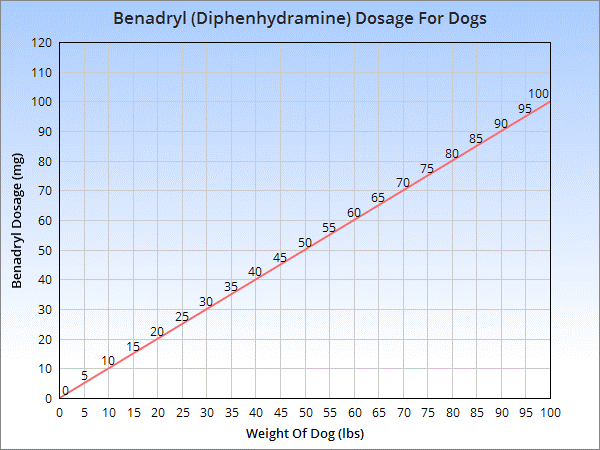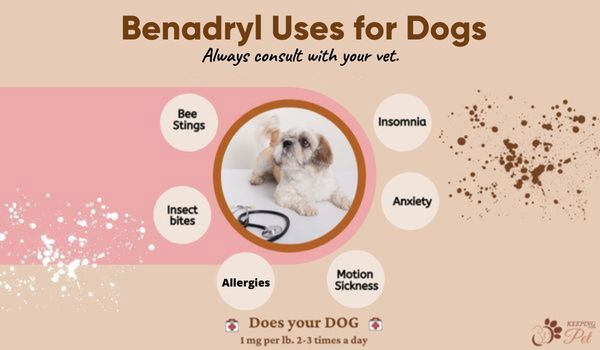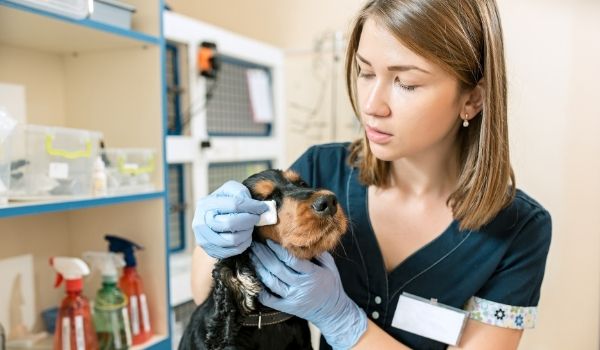Benadryl is a common over-the-counter medicine that you can occasionally find in your medicine cabinet. The active ingredient in Benadryl is Diphenhydramine Hydrogen Chloride, an antihistamine that is intended to relieve humans from allergies or allergy-like symptoms. However, numerous veterinary doctors have been prescribing a certain dosage of Benadryl for dogs and cats alike. It is a readily available over-the-counter drug that has been noted to calm down health concerns pet parents have when proper dosage and care are being taken.
The question remains when and how much Benadryl you can give to your dog. Let us walk you through the process.
The Suitable Benadryl Dosage for Dogs
It should be noted that Benadryl is simply the name of the company that sells the drug and not the actual drug. Thus, while purchasing Benadryl for your dog, the composition of the tablet must be checked first.
The general rule applies; the dosage for your dog is determined by the weight of your dog. That said, according to Pet MD, for every pound your dog is allowed 1 mg of the medicine. It is always best to remain on the safe side and start with a smaller dose. The frequency should always be with a gap of 6 – 8 hours between the administered doses.
Here’s the dog benadryl dosage chart to keep things simple.

And a table keeping track of all the different forms of Benadryl:
| Weight of Your Dog | Tablet Form (mg) | Children’s Liquid Form (ml) |
| 1 lbs. – 10 lbs. | 1 mg – 10 mg | 0.4 ml – 4 ml |
| 10 lbs. – 20 lbs. | 10 mg – 20 mg | 4 ml – 8 ml |
| 20 lbs. – 30 lbs. | 20 mg – 30 mg | 8 ml – 12 ml |
| 30 lbs. – 40 lbs. | 30 mg – 40 mg | 12 ml – 16 ml |
| 40 lbs. – 50 lbs. | 40 mg – 50 mg | 16 ml – 20 ml |
| 50 lbs. – 60 lbs. | 50 mg – 60 mg | 20 ml – 24 ml |
| 60 lbs. – 70 lbs. | 60 mg – 70 mg | 24 ml – 28 ml |
| 70 lbs. – 80 lbs. | 70 mg – 80 mg | 28 ml – 32 ml |
| 80 lbs. – 90 lbs. | 80 mg – 90 mg | 32 ml – 36 ml |
| 90 lbs. – 100 lbs. | 90 mg – 100 mg | 32 ml – 36 ml |
| 100 lbs. – 110 lbs. | 100 mg – 110 mg | 40 ml – 44 ml |
| 110 lbs. – 120 lbs. | 110 mg – 120 mg | 44 ml – 48 ml |
| 120 lbs. – 130 lbs. | 120 mg – 130 mg | 48 ml – 52 ml |
| 130 lbs. – 140 lbs. | 130 mg – 140 mg | 52 ml – 56 ml |
| 140 lbs. – 150 lbs. | 140 mg – 150 mg | 56 ml – 60 ml |
Disclaimer:
Before administering any sort of medicine, FDA approved or otherwise, one must always confer with their doctors in question as side effects might prevail if given prematurely.
Benadryl Uses for Dogs
Benadryl, although not FDA-approved for animals, has been known to cure a variety of symptoms in dogs and even cats.
Veterinary doctors prescribe it for the following symptoms:
Allergies
Seasonal allergies or even bee stings can be treated with Benadryl. It reduces the effects of allergic reactions by preventing the uptake of histamine in the body. Thus, it can be used to relieve symptoms of watery eyes, inflammation, and certain rashes on the skin.
Anxiety
Certain dogs tend to get agitated or overwhelmed by loud noises. The calming properties of Benadryl come in handy in situations like these; thunderstorms or firework season i.e. the fourth of July.
Irritation
Reaction to insect bites and discomfort may be cured by a dose of Benadryl
Insomnia
One of the common side effects of Benadryl is drowsiness, the Nytol present in the compound can help put your dog to ease and eventually fall asleep.
Motion Sickness
During travel or any sort of trip, motion sickness can be avoided by Benadryl. The active ingredient Diphenhydramine treats nausea and thus, blocks the part of the brain that could cause your dog to experience motion sickness.
Benadryl and its Forms
Tablet
One tablet of Benadryl is usually 25 mg. If you’re trying to give it to your dog in the form of a tablet, it would be wise to hide it in his food, or a treat, so that he takes it willingly and swallows. Saving you the struggle.
Children’s Formula
This form is essentially the easiest way to administer to canines. The children’s formula version contains zero alcohol hence making it safe for your dogs as well. The low composition of Benadryl in the formula also makes it easier to measure dosage for puppies and convenient to administer.
Topical
Restricted use of topical Benadryl can be applied directly to your dog’s rash on the skin. It will relieve discomfort. However, prolonged use is not recommended for canines.
Injection
Under emergency circumstances, veterinary doctors may administer an injection of Benadryl to your pet dog.
Liquid
Benadryl in liquid form is not safe for dogs as it contains alcohol. Avoid it at all costs.
Common Side Effects
Benadryl, although prescribed by veterinary doctors worldwide, could have some common side effects. Here’s what you need to be aware of and what you need to be worried about. Some of the most prevalent side effects are drowsiness, urine retention, increased heart rate, and hypersalivation. At times side effects such as diarrhea, vomiting, and loss of appetite may also prevent themselves.
However, all the mentioned symptoms can be prevented by the administration of the proper dosage of Benadryl to your dog. Thus, always be careful with the quantity you’re allowing your pet, and make a habit of consulting your doctor before providing any medicine.
When to Not Give Your Dog Benadryl
Dogs with certain health concerns or conditions must not be given Benadryl as it could cause adverse effects.
Canines with the following health conditions should not be administered Benadryl:
- Bladder issues
- Pregnant or nursing
- Hypertension
- High blood pressure
- Low blood pressure
- Seizure disorder
- Glaucoma
- Hyperthyroidism
Once you keep in check all the boxes, Benadryl can be a convenient method to solve health concerns for your furry little friends. Just keep in mind to always remain in contact with your veterinary doctor. Otherwise, you are good to go.



